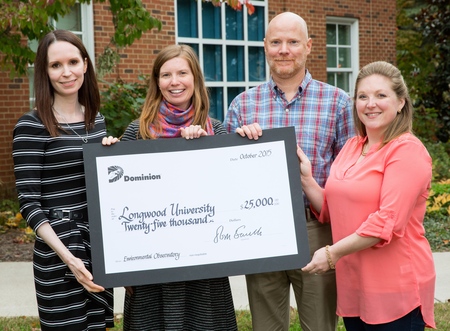
When Longwood University faculty members needed technical help with an environmental education project, they found it across campus rather than across the country.
They were looking for assistance with the environmental sensor network being built mainly by faculty members in the Department of Biological and Environmental Sciences. Computer science professor Dr. Robert Marmorstein and one of his students, Hunter Plumley ’16, were glad to help.
The wireless network Marmorstein and Plumley built helped bring the Longwood Environmental Observatory (LEO) to life. LEO collects near real-time data on soil, water and weather from two off-campus sites. The environmental sensor network, in which other students have played a key role, makes the data publicly available, supporting education and research.
The first part of LEO has been installed at Hull Springs Farm, a 660-acre Longwood property in Westmoreland County. A similar system will be brought online next year near the Environmental Education Center at Lancer Park.
"This network will provide real-world data sets for our students to work with," said Dr. Kathy Gee, coordinator of the integrated environmental sciences program. "Real-world data always makes students more enthusiastic. They connect with it better."
All of the faculty members involved in the project (also Dr. Ken Fortino and Dr. Dina Leech in biology and Dr. Chris Labosier in environmental science) plan to use LEO-derived data in their classes. Students already are reaping educational benefits.
"Students are helping design portions of the LEO network at Lancer Park," said Gee. "Also, students in my upper-level watershed monitoring and assessment class are gaining real-world experience by helping design and implement a monitoring plan. Future classes will use the data from the monitoring to analyze real-world environmental systems."
Two students have been instrumental in developing the LEO project, which Dr. Mark Fink, chair of the Department of Biological and Environmental Sciences, called an "exciting STEM collaboration that will serve not only the sciences and mathematics but other disciplines and the greater community as well."
Plumley’s role evolved from his longtime interest in electronics and hardware design. He selected hardware, did wiring and soldering, and helped install the sensors at Hull Springs. He also performed physical labor, such as digging trenches and running PVC pipe.
"Because our computer science program is mostly software design, it’s rare to find a student with Hunter’s hardware experience," said Marmorstein, associate professor of computer science.
Rachel Lombardi ’16, an integrated environmental sciences major, also has played a key role. She calibrated the sensors, wrote a calibration protocol that future students can use and, like Plumley, also rolled up her sleeves at Hull Springs, including digging postholes.
"Rachel has been a tremendous asset to our team," said Gee. "She is a quick learner who has provided a tremendous amount of support and knowledge."
In another research project in summer 2015 in which Gee and Lombardi installed a "smart" rainwater harvesting system at Lancer Park, Plumley and Marmorstein did similar technical work. In both projects, the computer duo designed and installed microcontrollers, small computerlike devices that are electrically connected to the sensors and can be programmed to interact with sensors and motors.
Lombardi and Plumley will continue their LEO involvement at Lancer Park, an apartment complex near campus, where work is expected to begin this fall.
LEO data has been collected from Hull Springs, where a sensor network was installed this past summer, funded by Longwood’s SOLSTICE program. Installation of similar sensors at Lancer Park is being funded by a $25,000 gift from the Dominion Foundation. Both sites are expected to produce usable data by fall 2016.
Water data includes water quality and temperature, and levels of dissolved oxygen, pH salinity, chlorophyll and organic matter in the water. Weather data includes temperature, air pressure, humidity, wind speed and direction, and solar radiation. Soil-moisture data also is collected.
"The remote collection of environmental data that is publicly available, which hasn’t always been the case with this kind of data, will be a wonderful resource for researchers and our students," said Fortino.
Project organizers are currently tweaking the network at Hull Springs and preparing for the Lancer Park work. Once LEO is complete, data readings taken every 15 minutes will be wirelessly streamed back to campus, where anyone can peruse the information on a publicly accessible website. "The finished product will be very impressive," said Gee.

